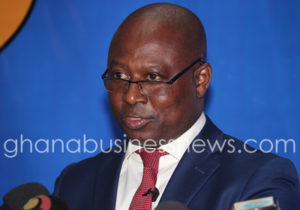Bank of Ghana maintains policy rate at 25.5%

The Bank of Ghana has maintained the policy rate or interest rate at 25.5 per cent.
The Governor of the central bank made the announcement at a press conference in Accra Monday January 23, 2017.
Dr. Abdul-Nashiru Issahaku indicated that headline inflation continues to ease, closing the year at 15.4 per cent from 15.8 per cent in October 2016.
“This was supported by tight monetary policy and relative stability of the exchange rate. Similarly, underlying inflation pressures, measured by core inflation (CPI excluding energy and utility prices) declined significantly. From 15.2 per cent in October, core inflation fell to 14.7 per cent in November, and further to 14.6 percent in December 2016,” he said, adding that, inflation expectations by consumers and the financial sector eased in line with trends in headline inflation.
He noted that these developments in headline inflation during the year were broadly in line with the Bank’s 2016 forecasts.
According to him, at this MPC round, however, the underlying assumptions in the forecasting framework were revised to reflect the recent upward adjustments in ex-pump prices, exchange rate depreciation and a higher than budgeted fiscal deficit outturn for 2016.
“Consequently, the baseline forecast horizon for the medium term inflation target has shifted into 2018. This inflation outlook could however improve if the fiscal consolidation process is restored, alongside monetary policy tightness and exchange rate stability,” he said.
Dr. Issahaku pointed out that economic activity remained modest throughout the year, against the backdrop of policy tightness, oil and gas production challenges at the Jubilee field, and lingering consequences of the power supply constraints.
He said, the updated CIEA to November 2016 points to some moderation in the pace of economic activity reflecting declines in industrial consumption of electricity, cement sales, tourist arrivals and domestic VAT collection.
“However, the latest consumer sentiments survey conducted after the December 2016 polls reflected optimism about economic prospects. In addition, the expected increase in oil production from Tweneboa-Enyenra-Ntomme (TEN) and coming on stream of the Sankofa-Gye Nyame oil fields are expected to boost growth in 2017,” he said, confirming forecasts for Ghana by the World Bank, International Monetary Fund and rating agency Moody’s. These institutions have projected economic growth for Ghana as the TEN oil field and Sankofa Gas field comes into full production to around 17 per cent.
He noted that provisional fiscal data for the year to November 2016 indicated a budget deficit of 7.0 percent of GDP, against a target of 4.7 percent. The fiscal slippage was mainly attributed to shortfalls in revenues. Government expenditures, on the other hand, were broadly within target. The fiscal outturn for 2016 presents challenges to the inflation outlook.
By Emmanuel K. Dogbevi
